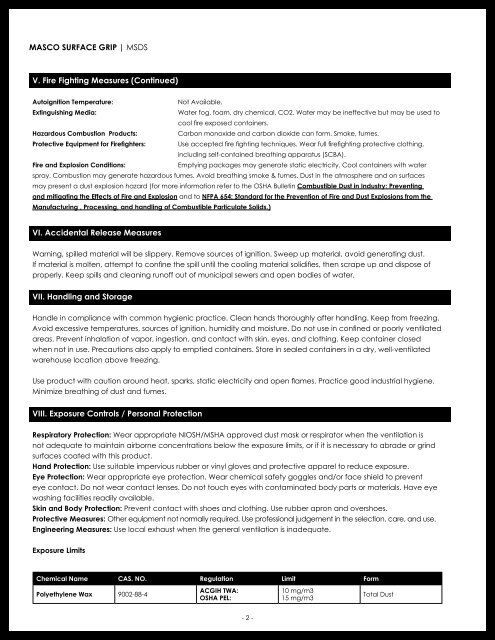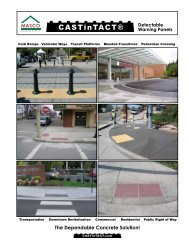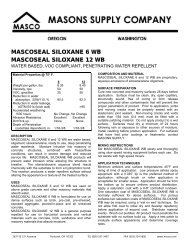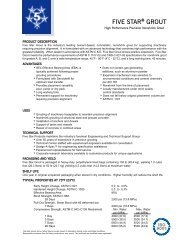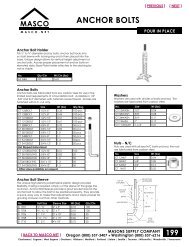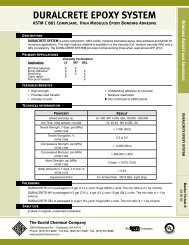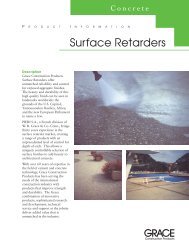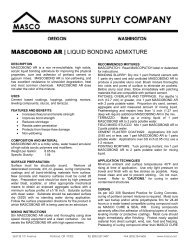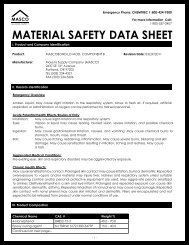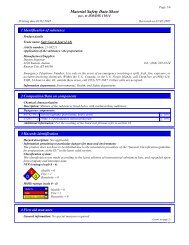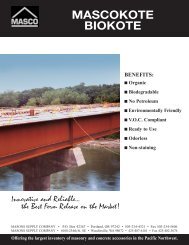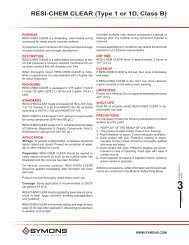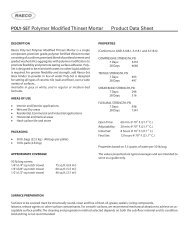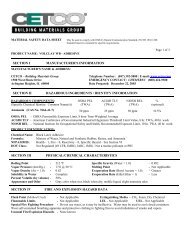MSDS - masco.net
MSDS - masco.net
MSDS - masco.net
Create successful ePaper yourself
Turn your PDF publications into a flip-book with our unique Google optimized e-Paper software.
MASCO SURFACE GRIP | <strong>MSDS</strong><br />
V. Fire Fighting Measures (Continued)<br />
Autoignition Temperature:<br />
Not Available.<br />
Extinguishing Media:<br />
Water fog, foam, dry chemical, CO2. Water may be ineffective but may be used to<br />
cool fire exposed containers.<br />
Hazardous Combustion Products:<br />
Carbon monoxide and carbon dioxide can form. Smoke, fumes.<br />
Protective Equipment for Firefighters: Use accepted fire fighting techniques. Wear full firefighting protective clothing,<br />
including self-contained breathing apparatus (SCBA).<br />
Fire and Explosion Conditions:<br />
Emptying packages may generate static electricity. Cool containers with water<br />
spray. Combustion may generate hazardous fumes. Avoid breathing smoke & fumes. Dust in the atmosphere and on surfaces<br />
may present a dust explosion hazard (for more information refer to the OSHA Bulletin Combustible Dust in Industry: Preventing<br />
and mitigating the Effects of Fire and Explosion and to NFPA 654: Standard for the Prevention of Fire and Dust Explosions from the<br />
Manufacturing , Processing, and handling of Combustible Particulate Solids.)<br />
VI. Accidental Release Measures<br />
Warning, spilled material will be slippery. Remove sources of ignition. Sweep up material, avoid generating dust.<br />
If material is molten, attempt to confine the spill until the cooling material solidifies, then scrape up and dispose of<br />
properly. Keep spills and cleaning runoff out of municipal sewers and open bodies of water.<br />
VII. Handling and Storage<br />
Handle in compliance with common hygienic practice. Clean hands thoroughly after handling. Keep from freezing.<br />
Avoid excessive temperatures, sources of ignition, humidity and moisture. Do not use in confined or poorly ventilated<br />
areas. Prevent inhalation of vapor, ingestion, and contact with skin, eyes, and clothing. Keep container closed<br />
when not in use. Precautions also apply to emptied containers. Store in sealed containers in a dry, well-ventilated<br />
warehouse location above freezing.<br />
Use product with caution around heat, sparks, static electricity and open flames. Practice good industrial hygiene.<br />
Minimize breathing of dust and fumes.<br />
VIII. Exposure Controls / Personal Protection<br />
Respiratory Protection: Wear appropriate NIOSH/MSHA approved dust mask or respirator when the ventilation is<br />
not adequate to maintain airborne concentrations below the exposure limits, or if it is necessary to abrade or grind<br />
surfaces coated with this product.<br />
Hand Protection: Use suitable impervious rubber or vinyl gloves and protective apparel to reduce exposure.<br />
Eye Protection: Wear appropriate eye protection. Wear chemical safety goggles and/or face shield to prevent<br />
eye contact. Do not wear contact lenses. Do not touch eyes with contaminated body parts or materials. Have eye<br />
washing facilities readily available.<br />
Skin and Body Protection: Prevent contact with shoes and clothing. Use rubber apron and overshoes.<br />
Protective Measures: Other equipment not normally required. Use professional judgement in the selection, care, and use.<br />
Engineering Measures: Use local exhaust when the general ventilation is inadequate.<br />
Exposure Limits<br />
Chemical Name CAS. NO. Regulation Limit Form<br />
Polyethylene Wax 9002-88-4<br />
ACGIH TWA:<br />
OSHA PEL:<br />
10 mg/m3<br />
15 mg/m3<br />
Total Dust<br />
- 2 -


